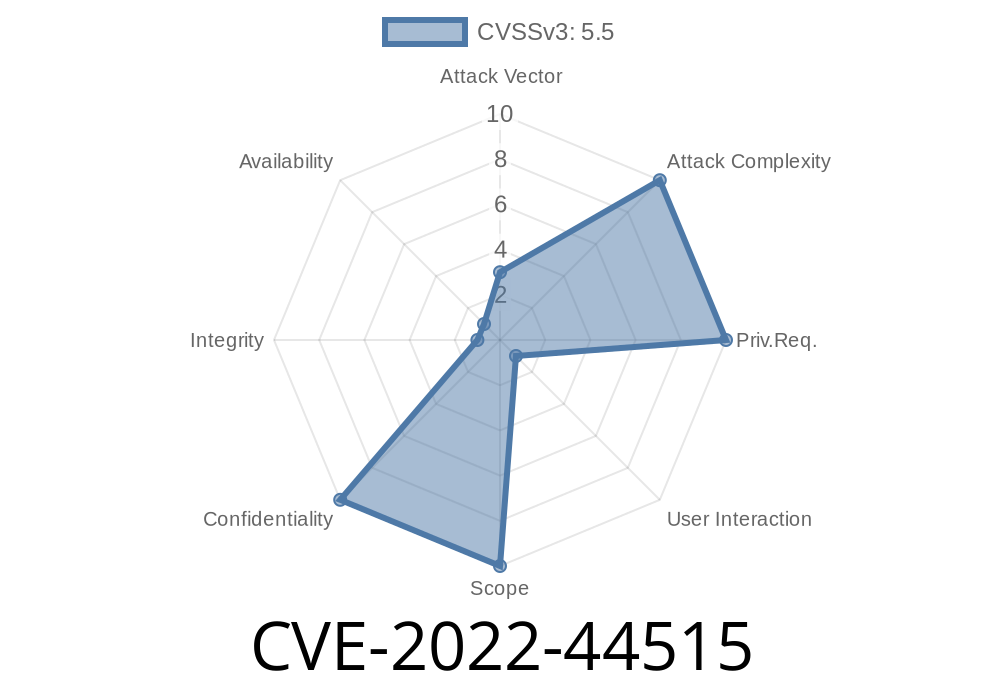CVE-2022-44515 is a real headache for users of Adobe Acrobat Reader DC. If you’re running versions 22.001.20085 (and earlier), 20.005.3031x (and earlier), or 17.012.30205 (and earlier), you should stop, update, and read on. This post explains how attackers can use a cleverly crafted PDF file to poke into places in memory they’re not supposed to—a problem known as an out-of-bounds read. We'll dive into simple details, code snippets, and how this can be exploited, so you understand the real risk.
What Is an Out-of-Bounds Read?
Let’s keep this simple. Imagine your living room has a wall—the memory’s boundary. If you reach past that wall to grab something in your neighbor’s house (another memory space), you’re reading out-of-bounds. In computer terms, programs are supposed to play within the memory they're given. With CVE-2022-44515, hackers can craft a PDF that tells Acrobat Reader DC to look beyond its memory "room," reading information it shouldn’t have access to. This can lead to leaking memory addresses, which attackers can use to bypass security like ASLR (Address Space Layout Randomization).
How Is Acrobat Reader Affected?
According to Adobe’s Security Bulletin, multiple versions are affected:
Acrobat Reader 2017 17.012.30205 and earlier
An attacker needs to convince someone to open a malicious PDF file—that’s the only “interaction” needed.
1. Create a Malicious PDF
Attackers can use tools like PDF Exploit Frameworks or even Python scripts with libraries like PyPDF2 to create malformed PDFs. The crafted PDF contains objects that, when parsed, force Acrobat to read past the end of a buffer.
2. Trigger the Vulnerability
Here’s a simple Python pseudocode snippet showing how one might create a slightly broken XREF table—the part of a PDF that Acrobat uses to find objects:
from PyPDF2 import PdfWriter
writer = PdfWriter()
writer.add_blank_page(width=72, height=72)
with open('malicious.pdf', 'wb') as f:
writer.write(f)
# Manually mess with the xref (cross-reference) table in malicious.pdf using a hex editor
# For example: add an xref pointer that goes outside actual object bounds
# Example: Entry "00000099 65535 f" where 99 is an invalid offset past file end
When Acrobat parses this, it might read data beyond the allocated buffer, pulling leaked values from memory.
3. Information Leak and ASLR Bypass
Attackers can read undesired memory, possibly learning ASLR-protected addresses or even snippets of sensitive information. This won’t let someone run code right away, but combined with other vulnerabilities, it’s a vital puzzle piece for a full attack.
Proof of Concept: Variant in C
To demonstrate the underlying logic, here’s a simplified C version of the kind of coding mistake Acrobat Reader might contain—a buffer overrun:
#include <stdio.h>
#include <string.h>
void parse_pdf_object(const char *pdf_data, size_t len) {
char buffer[512];
// Mistakenly reads more data than allocated
memcpy(buffer, pdf_data, 1024); // Oops! Only 512 bytes available!
// code continues, buffer now contains out-of-bounds memory
}
int main() {
char malicious_data[1024] = {};
// Fill malicious_data with arbitrary values
parse_pdf_object(malicious_data, sizeof(malicious_data));
return ;
}
*Note: This example shows what’s conceptually happening, not the real Acrobat code.*
Impact & Real-World Risk
- ASLR Bypass: Attackers can get memory addresses, making further exploitation (like running malicious code) much easier.
- Sensitive Data Leak: Sometimes, private data (even passwords) might be in those overlooked memory spaces.
Exploit References & Further Reading
- Adobe Security Advisory, CVE-2022-44515
- NVD Entry for CVE-2022-44515
- PDF Exploit Framework
- How ASLR Bypass Works
- PyPDF2 Documentation
Conclusion
CVE-2022-44515 is one piece of a much bigger puzzle hackers use to break into systems. While it doesn’t let someone take over your computer alone, combine it with other bugs and you’re in trouble. Keep your software updated and don’t take PDF files from strangers—there’s more at risk than you might think.
Timeline
Published on: 12/19/2024 00:15:05 UTC
